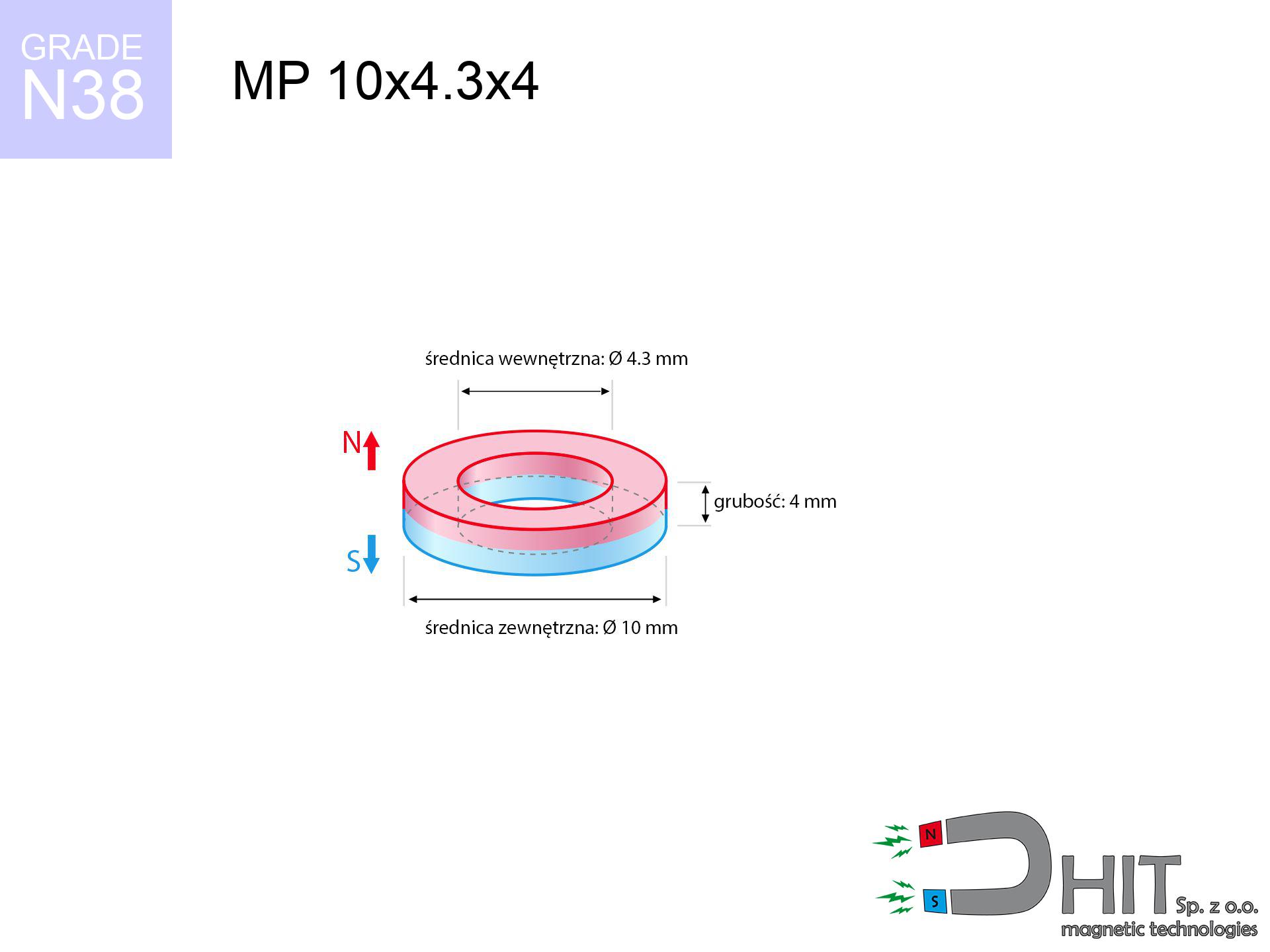MP 10x4.3x4 / N38 - ring magnet
ring magnet
Catalog no 030178
GTIN: 5906301811954
Diameter [±0,1 mm]
10 mm
internal diameter Ø [±0,1 mm]
4.3 mm
Height [±0,1 mm]
4 mm
Weight
5.37 g
Magnetization Direction
↑ axial
Load capacity
0.98 kg / 9.61 N
Magnetic Induction
157.60 mT
Coating
[NiCuNi] nickel
1.045 ZŁ with VAT / pcs + price for transport
0.850 ZŁ net + 23% VAT / pcs
bulk discounts:
Need more?Not sure about your choice?
Contact us by phone
+48 22 499 98 98
or let us know by means of
request form
the contact form page.
Parameters as well as structure of a magnet can be tested using our
magnetic mass calculator.
Orders submitted before 14:00 will be dispatched today!
Magnetic properties of material N38
Physical properties of sintered neodymium magnets Nd2Fe14B at 20°C
Shopping tips
Advantages as well as disadvantages of NdFeB magnets.
In addition to their magnetic capacity, neodymium magnets provide the following advantages:
- They do not lose strength, even after nearly ten years – the decrease in power is only ~1% (based on measurements),
- They show high resistance to demagnetization induced by presence of other magnetic fields,
- A magnet with a metallic nickel surface has an effective appearance,
- The surface of neodymium magnets generates a concentrated magnetic field – this is one of their assets,
- Neodymium magnets are characterized by extremely high magnetic induction on the magnet surface and can work (depending on the form) even at a temperature of 230°C or more...
- Possibility of accurate machining and optimizing to complex requirements,
- Wide application in future technologies – they are utilized in hard drives, brushless drives, medical devices, as well as modern systems.
- Relatively small size with high pulling force – neodymium magnets offer high power in tiny dimensions, which allows their use in small systems
Cons of neodymium magnets and proposals for their use:
- They are prone to damage upon heavy impacts. To avoid cracks, it is worth securing magnets in a protective case. Such protection not only shields the magnet but also improves its resistance to damage
- When exposed to high temperature, neodymium magnets suffer a drop in force. Often, when the temperature exceeds 80°C, their strength decreases (depending on the size, as well as shape of the magnet). For those who need magnets for extreme conditions, we offer [AH] versions withstanding up to 230°C
- Magnets exposed to a humid environment can corrode. Therefore during using outdoors, we suggest using water-impermeable magnets made of rubber, plastic or other material resistant to moisture
- We suggest cover - magnetic holder, due to difficulties in creating threads inside the magnet and complex shapes.
- Possible danger related to microscopic parts of magnets pose a threat, in case of ingestion, which gains importance in the context of child health protection. Additionally, small elements of these magnets are able to complicate diagnosis medical after entering the body.
- High unit price – neodymium magnets cost more than other types of magnets (e.g. ferrite), which increases costs of application in large quantities
Breakaway strength of the magnet in ideal conditions – what it depends on?
Breakaway force was defined for the most favorable conditions, assuming:
- on a base made of mild steel, perfectly concentrating the magnetic field
- possessing a thickness of min. 10 mm to avoid saturation
- with a surface cleaned and smooth
- with direct contact (no paint)
- under vertical force vector (90-degree angle)
- at room temperature
Practical aspects of lifting capacity – factors
It is worth knowing that the application force may be lower depending on elements below, in order of importance:
- Air gap (between the magnet and the metal), since even a very small clearance (e.g. 0.5 mm) leads to a reduction in lifting capacity by up to 50% (this also applies to paint, corrosion or debris).
- Direction of force – maximum parameter is reached only during perpendicular pulling. The shear force of the magnet along the plate is usually several times lower (approx. 1/5 of the lifting capacity).
- Element thickness – to utilize 100% power, the steel must be adequately massive. Thin sheet limits the attraction force (the magnet "punches through" it).
- Metal type – different alloys reacts the same. High carbon content worsen the interaction with the magnet.
- Surface finish – ideal contact is possible only on smooth steel. Rough texture reduce the real contact area, reducing force.
- Heat – NdFeB sinters have a sensitivity to temperature. When it is hot they are weaker, and in frost they can be stronger (up to a certain limit).
* Lifting capacity testing was conducted on plates with a smooth surface of optimal thickness, under perpendicular forces, whereas under attempts to slide the magnet the load capacity is reduced by as much as 75%. In addition, even a minimal clearance {between} the magnet’s surface and the plate reduces the load capacity.
Warnings
Pacemakers
Medical warning: Neodymium magnets can turn off pacemakers and defibrillators. Do not approach if you have medical devices.
Skin irritation risks
Warning for allergy sufferers: The nickel-copper-nickel coating contains nickel. If an allergic reaction happens, immediately stop handling magnets and wear gloves.
Fragile material
Despite metallic appearance, the material is delicate and cannot withstand shocks. Avoid impacts, as the magnet may crumble into sharp, dangerous pieces.
Power loss in heat
Regular neodymium magnets (N-type) lose power when the temperature surpasses 80°C. This process is irreversible.
GPS Danger
Be aware: neodymium magnets generate a field that interferes with sensitive sensors. Keep a safe distance from your mobile, device, and GPS.
Threat to electronics
Powerful magnetic fields can corrupt files on credit cards, hard drives, and storage devices. Maintain a gap of min. 10 cm.
Bodily injuries
Protect your hands. Two large magnets will join immediately with a force of several hundred kilograms, destroying everything in their path. Exercise extreme caution!
Choking Hazard
Only for adults. Tiny parts can be swallowed, causing serious injuries. Store away from kids and pets.
Mechanical processing
Combustion risk: Neodymium dust is highly flammable. Avoid machining magnets without safety gear as this may cause fire.
Powerful field
Use magnets with awareness. Their huge power can surprise even experienced users. Be vigilant and respect their force.
Safety First!
Want to know more? Check our post: Are neodymium magnets dangerous?






![BM 550x180x70 [4x M8] - magnetic beam BM 550x180x70 [4x M8] - magnetic beam](https://cdn3.dhit.pl/graphics/products/bm-550x180x70-4x-m8-nic.jpg)
![SM 32x375 [2xM8] / N42 - magnetic separator SM 32x375 [2xM8] / N42 - magnetic separator](https://cdn3.dhit.pl/graphics/products/sm-32x375-2xm8-nif.jpg)

